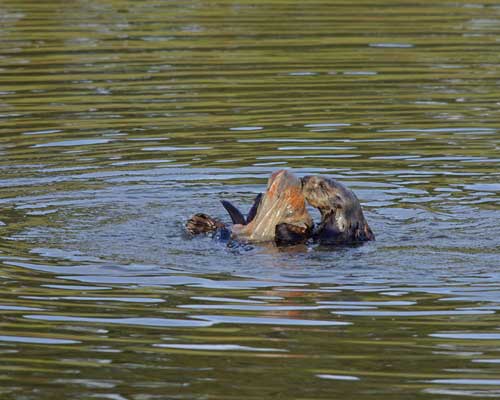Plastic shopping bags: Modern-day tumbleweed?
Last August, SeaWorld Parks & Entertainment announced it would remove plastic shopping bags at all its theme parks, establishing it as the largest theme park operator to establish this commitment. Park gift shops will now offer paper bags made from 100% recycled paper or guests can choose to use reusable bags.
February 4, 2013

Last August, SeaWorld Parks & Entertainment announced it would remove plastic shopping bags at all its theme parks, establishing it as the largest theme park operator to establish this commitment. Park gift shops will now offer paper bags made from 100% recycled paper or guests can choose to use reusable bags.
This will keep an estimated 4 million plastic bags from entering landfills and the environment each year. SeaWorld stated approximately 1.4 billion tons of trash, including plastic bags, enter the ocean annually. Wildlife such as endangered sea turtles often mistake plastic bags for jellyfish, one of their favorite foods.
 "SeaWorld Parks & Entertainment has a long history of actively supporting sea turtle conservation and rescues hundreds of these animals each year in the wild that have been impacted by human behavior," a SeaWorld spokesperson told PlasticsToday. "This change is natural for us and provides an opportunity to communicate to guests how they, too, can help make a difference for these animals."
"SeaWorld Parks & Entertainment has a long history of actively supporting sea turtle conservation and rescues hundreds of these animals each year in the wild that have been impacted by human behavior," a SeaWorld spokesperson told PlasticsToday. "This change is natural for us and provides an opportunity to communicate to guests how they, too, can help make a difference for these animals."
SeaWorld hoped that this not only inspire change for the company, but provide a model for the industry overall.
"Eliminating plastic bags is an important statement about our commitment to the environment, as well as the need to help protect marine animals from debris," said Jim Atchison, president and CEO of SeaWorld Parks & Entertainment. "It also allows our guests to play a direct part in making a difference on our planet."
When it comes to plastic shopping bags and bans, both sides of the argument proudly and loudly shout their opinions. But there is one party without a voice in the debate that could be feeling very real consequences: marine life.
Relationship between bags and marine mammals
The National Resources Defense Council (NRDC) claims that we, as a society, treat the oceans like a trash bin, and plastic accounts for 60-80% of marine litter. During the past 25 years, plastic shopping bags represent one of the top items found by International Coastal Cleanup volunteers.
"We're fully aware that plastic bags are not the only form of waste that gets into the ocean," said Leila Monroe, staff attorney for the oceans program at the NRDC. "But there is no denying that it's a lightweight product that is easily blown into storm drains or can get carried into the ocean."
Supporting that statement, there have been multiple documented cases of marine mammals suffering due to plastic bags. For instance, a shopping plastic bag was blamed for the death of a beached whale in the Cook Islands in the South Pacific Ocean; a gray whale that died after getting stranded on a West Seattle beach and found to have consumed a large amount of garbage, including sweat pants, a golf ball and plastic bags; or the story of a baby otter that got stuck in a plastic bag in Moss Landing Harbor, before eventually getting free.
bags. For instance, a shopping plastic bag was blamed for the death of a beached whale in the Cook Islands in the South Pacific Ocean; a gray whale that died after getting stranded on a West Seattle beach and found to have consumed a large amount of garbage, including sweat pants, a golf ball and plastic bags; or the story of a baby otter that got stuck in a plastic bag in Moss Landing Harbor, before eventually getting free.
Many proponents of plastic bag ordinances use stories and pictures of animals in danger to support the case for cities to adopt plastic bag bans. The grassroots campaign Save Our Shores states that, "Communities free of plastic bags lead to healthier oceans and rivers free of plastic pollution." The site includes a running list of California communities that have either passed plastic bag bans or have potential bans currently in progress.
Perception vs. factual data
There's a widely circulated statistic that plastic bags (sometimes just referenced to as plastic debris) kills upwards to 100,000 mammals and 1 million seabirds a year.
That figure is false, however, according to a 2008 article in the Times of London.
The article explored the concept that the fight against plastic bags was partly based on inconsistent science. The report claims this figure is actually a misinterpretation of a 1987 Canadian study that stated the marine mammals and birds were actually killed by discarded nets.
It turns out it's very difficult to find statistics that can firmly quantify how plastic bags have harmed wildlife. Most of the reports cite the 100,000 statistic. The National Oceanic Atmospheric Administration (NOAA) says that figure is "possible, but difficult to say with certainty."
To date, there are no published studies that document how many marine mammals die each year due to debris, NOAA stated. The closest NOAA could find was seabirds killed due to entanglement from lost fishing gear. There was no mention of plastic bags in relation to marine mammals mortality.
Plastic debris
The United Nations Environment Program estimates around 13,000 pieces of plastic litter are found in every square kilometer of sea. Plastic debris in the ocean is a potentially fatal concern for some mammals that can mistake it for food sources.
 Polyethylene, while it's recyclable, can last up to hundreds of years in the environment if it's left untouched. According to researchers from Department of Biotechnology Engineering, at the Ben-Gurion University of the Negev in Israel, previous studies showed no signs of deterioration could be observed in a polyethylene sheet that had been incubated in moist soil for 12 years and only partial degradation was observed in a polyethylene film buried in soil for 32 years.
Polyethylene, while it's recyclable, can last up to hundreds of years in the environment if it's left untouched. According to researchers from Department of Biotechnology Engineering, at the Ben-Gurion University of the Negev in Israel, previous studies showed no signs of deterioration could be observed in a polyethylene sheet that had been incubated in moist soil for 12 years and only partial degradation was observed in a polyethylene film buried in soil for 32 years.
It doesn't degrade, but polyethylene eventually breaks down into smaller and smaller pieces.
In a paper published by the journal Biology Letters, scientists from Scripps Institute of Oceanography, who concentrated their studies a thousand miles west of California, reported the amount of plastic debris in the North Pacific Ocean has grown 100-fold in the past 40 years. But the pieces are so tiny that the researchers weren't able to trace the waste to any particular type of plastic packaging, said Miriam Goldstein, lead author of the study.
"We can't tell what the objects are or how long that piece of plastic has been in the ocean," she said. "I think everyone-activists, scientists, and the industry-agrees plastics has no place in ocean."
In general, plastic litter comes in a wide variety of sizes and compositions and has been found throughout the world's ocean, carried by currents and biological vectors, according to Marine Litter Solutions. Plastics degrade extremely slowly in the open ocean, partly due to UV absorption by seawater and relatively low temperatures.
Still, some believe it's unfair to point the finger primarily at plastics. They believe it is a lack of waste management infrastructure and poor societal behavior that are allowing plastic litter to enter the marine environment. Plastic bags, in particular, are an easy target due to their lightweight, durability and visible presence.
"Plastic bags don't throw themselves into seas or landfills," said Sukhraj Poonia, research and communication manager for the UK Packaging and Films Association (PAFA). "Someone sees plastic bags floating around and subconsciously that person might believe plastic bags equal litter, and to me, that is the wrong way to look at it. Littering is morally wrong regardless of the product and this so-called 'war on plastic bags' takes away the accountability of human behavior."
Read part 1 of PlasticsToday's comprehensive plastic bag ban report.
Read part 3 of PlasticsToday's comprehensive plastic bag ban report.
About the Author(s)
You May Also Like


